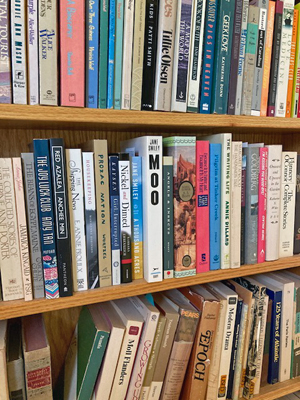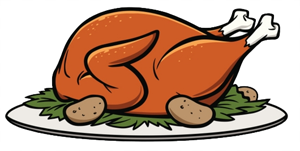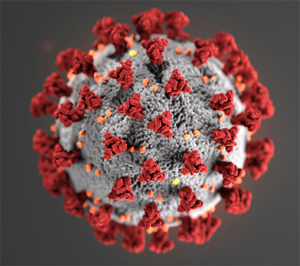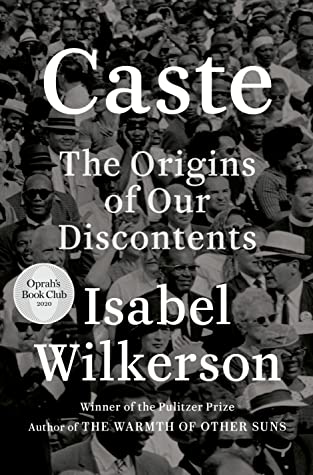
Over this Turkey Day weekend, I’ve begun reading Gabriel Garcia Marquez’s brilliant Love in the Time of Cholera (in this age of coronavirus, it seemed appropriate).
You don’t read Marquez, you climb on the sentences and paragraphs and ride them as if it were a roller coaster. The ups, the downs, the hard turns to the left and suddenly: Boom! You run into something you didn’t even see coming, even though it was foreshadowed about a page ago and you said….”nah….’.
Quite the ride.
It made me recall the only other Marquez book I’ve read, One Hundred Years of Solitude, which I read back in college and is – to me – one of the best books of the 20th Century.
Which got me to thinking – what are the best, or more correctly, my favorite books?
Tried to keep it to the “Top Ten” of each (fiction/non-fiction); it’s what I feel right now.
Fiction
- Brothers Karamazov (Fyodor Dostoevsky): — The quintessential Russian novel by my favorite Russian author.
- Slaughterhouse Five (Kurt Vonnegut): — This book, based in Vonnegut’s witnessing of the firebombing of Dresden in WWII, is part biographical, part science fiction, and a scathing indictment if men’s willingness to kill each other. It’s subtitled “The Children’s Crusade.” So it goes.
- The Adventures of Augie March (Saul Bellow): — Set in Chicago (as am I), this book is probably Bellow’s most joyous. While Herzog is probably his richest literary endeavor, I prefer the tale of Augie March. The ending is a bit of a letdown, but the majority of the book is top shelf.
- The Sun Also Rises (Ernest Hemingway): — One of the Big Three of Hemingway’s novels (along with A Farewell to Arms and For Whom the Bell Tolls), this long piece is closer to his brilliant short stories – think “Hills Like White Elephants” or “The Short Happy Life of Francis Macomber.” Maybe novels should differ from short pieces, but who cares? This works. And the last few lines are achingly brilliant.
- The Sound and the Fury (William Faulkner): — My first Faulkner novel; I could have picked many others (Light in August; the macabre As I Lay Dying etc.), but this mythological encapsulation of the South, like Dilsey (and by extension, all Southern blacks), has endured.
- Sophie’s Choice (William Styron): — A long, let-it-never-end book, this is an autobiographical tale that leans heavily on WWII and its aftermath. Sophie’s choice defines her (no spoilers). A book about immeasurable loss, madness, youth, missed youth, unbearable grief and how people manage – or fail to manage – same.
- One Hundred Years of Solitude (Gabriel Garcia Marquez): — Read the first couple sentences. Tell me you’re not at least … intrigued. A magical, mythic tale of generations of a family (even comes with a family chart – and it’s necessary).
- To the Lighthouse (Virginia Woolf): — King Lear re-imagined, and even more terrifying. I read this in one sitting back in college (where my main complaint was that I did not have time for recreational reading, which this was); the stream of consciousness just washes over you.
- Ulysses (James Joyce): — Sure, Finnegans Wake is his masterpiece, but it’s basically unreadable. I once spent an hour-long AP English class where the teacher and students dissected the meaning, iconography and so on of one paragraph of this tome. Ulysses is not a walk in the park, either, but if you stick with it it’s worth it. Read the poetry that is the last (pages-long) paragraph. I still get chills when I revisit this portion of the book, which I do a couple of times a year.
- The Handmaid’s Tale (Magaret Atwood): — Today – 2020 – it is fashionable to celebrate this novel: The HULU miniseries is a huge hit, and the handmaid’s outfit is often used to protest the actions of the increasingly conservative (and some say, anti-woman) leanings of the US Supreme Court and the current (Trump) administration. But I read this book as soon as I could get it in paperback (published 1985; my softcover is from 1988), and was blown away by the writing and the subject matter. The other book of Atwood’s that I read, Surfacing didn’t do much for me (subject or style), but this book is put together in a meticulous, almost constitutional manner. Much as the founders of the fictional Gilead built a new form of (icky) government and society, this book is no so much written as built, constructed. And I mean that as a high compliment. And the building/society that can be seen, in its protean form, is terrifying.
Non-fiction
- The Making of the Atomic Bomb (Richard Rhodes): — This door-stopper of a book won just about every award possible (including the Pulitzer Prize & National Book Award). It details the Manhattan Project and the aftermath of the Japanese bombings, but it begins with the physics that made it possible, going back to the turn of the 20th century with Clerk Maxwell, Ernest Rutherford and others. I had a friend who read the book comment, “You skipped over the boring science parts [neutrons, enrichment etc.], right?” No! Those were some of the best parts!
- Lab Girl (Hope Jahren): — The story of, in no particular order, the life of a female scientist (botanist), a mother with postpartum depression, and her work with her “work husband,” an odd but ultimately likeable fellow named Bill. It’s about living in Minnesota, Sweden and Hawaii. But – ultimately – it is about building labs to do the difficult, exhausting but ultimately rewarding work of pure research.
- Between the World and Me (Ta-Nehisi Coates): — Written as a letter to his then 15-year-old, the book threw me in the beginning as the author discussed how his body doesn’t belong to him, or how he lost his body. What? It took me a few (too many!) pages for me (white dude) to understand Coates (black dude): Black lives matter less than white lives; I can do to/get away with to Coates that he cannot get away with doing to me. Disagree/agree; he makes a strong case for the Black Lives Matter (BLM) movement, and the whole history of black oppression. This is a Very Important Book. Powerful without falling back on hyperbole. James Baldwin’s The Fire Next Time 2.0, forty years later.
- The Discoverers (Daniel Boorstin): — A deep yet accessible (no math) of man’s search for understanding our world. Basically, a history of science. Boorstin is a brilliant, effortless writer and he patiently explains the hows and whys man tried to understand our world (and beyond). Boorstin has written a couple of other books in similar vein: The Creators (artists/creative types) and The Seekers (philosopy/religion), but these are less compelling. The Discoverers has more science, and I do like science…
- The Song of the Dodo (David Quammen): — A book about the newish science of Island Biogeography and an age of extinction, but title is premised on a simple fact: We have, fairly recently (~1800), casually wiped out a species, the Dodo. Yet we have no idea what it sounded like, because we just didn’t…care. While more than 600 pages, it’s a great, accessible read that I greatly enjoyed, even though I’m more into the hard sciences (physics, chemistry, astronomy).
- The Periodic Table (Primo Levi): — A collection of self-contained chapters, each of which is about an element (surprise!). Levi picks expected (gold, uranium) and unexpected (tin, vanadium) elements (21 in all) and spins interesting tales of each. Levi – a Jewish Italian chemist – was imprisoned in a German concentration camp (Auschwitz) during WWII, has a chilling chapter detailing his post-war dealing with what turns out to be one of his German captors (a scientist who worked at the camp with Levi).
- A Room of One’s Own/Moments of Being (Virginia Woolf): — OK, two titles for one slot. But both are slim essays, and each is about the same two subjects: 1) Women’s rights/need for equality, and 2) some are more creative than others (man or woman). In the latter book, Woolf gets a little too close to Nietzsche’s Superman for me, but – overall – on the money. The former details that a woman needs to equal what a man has – an office, no child care during the day etc. – is. Many years ago, I read an article about the Iowa Writer’s Workshop (the Holy Grail for wanna-be writers). The author – a workshop student/alumni(?) said that the workshop was great for many reasons: fabulous teachers, spit-balling with other brilliant students and so on. But the one thing she (I think) focused on was the best offering of the workshop: You got “the time, the space and the quiet” to write. Sounds like a room of one’s own, hmm?
- Let Us Now Praise Famous Men (James Agee/Walker Evans): — This book is almost impossible to explain. As part of a magazine assignment, Agee and Evens went to the mid-Depression Era South (1936) to interview sharecroppers. The article was never published, but this book – with text by Agee and photos by Evans – capture a moment in time with painful precision. At the very least, read the introduction by Evans re: Agee: Even if you don’t know Agee, you will after reading this concise and unapologetic snapshot of Agee at the time. An overlooked American Masterpiece.
- Broadsides From the Other Orders (Sue Hubbell): — Subtitled, “A Book of Bugs.” And it is! I wrote a “Pest Control” column for a magazine at one point. I like botanical nomenclature, the Latin, the bugs themselves. So does Hubbell, much more than me. And it shows.
- Coming Into the Country (John McPhee): — The heir apparent to the clean New Yorker factual prose (from, among others, E.B. White), this book is a little different than most of McPhee’s books, which are essay collections (read them all, especially Giving Good Weight, my introduction to his clean, clear, insightful writing) – this one is a full book about one subject: The attempt to move the capital of Alaska from Juneau to Anchorage (which ultimately failed, but long after the book was published). Beautiful slice of life in the 49th state.
Yes, this is a weird list: Where is Catcher in the Rye, any Tolstoy (Wand and Peace is the better novel; Anna Karenina is my fav), why are there two Virginia Woolfs? Where is Kafka, one of my favorites?
That’s what I think today – tomorrow, different books. Some I would have forgotten if they were not on a bookshelf a few feet in front of me. I have hundreds of favorite books (and I’ve read plenty of stinkers, and those that I’ve just forgotten).
I like reading, and this is just a glimpse into the books I’ve enjoyed.



